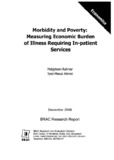Morbidity and poverty measuring economic burden of illness requiring inpatient services
Citation
Rahman, M., & Ahmed, S. M. (2006, December). Morbidity and poverty measuring economic burden of illness requiring inpatient services. Research Reports (2006): Health Studies, Vol - XXXIX, 113–145.Abstract
Severe illnesses may have important consequences for the poor in terms of the costs of
treatment they have to bear and income erosion effects of those illnesses. The resulting
depletion of wealth may also transmit poverty to the next generation. This study compared the
cost of illness between the Selected Ultra Poor (SUP) and the Not Selected Ultra Poor (NSUP)
households and investigated whether health expenditures are catastrophic. It also investigated
the crisis coping mechanism for meeting the cost burden of illness and its implications f{Jr the
poverty status of households. The survey interviewed SUP and NSU P households during
February-March 2006 in Rangpur, Nilphamari and Kurigram, drawn randomly from the
'Challenging the Frontiers of Poverty Reduction- Targeting the Ultra Poor (CFPR/TUP) Repeat
Survey 2005' based on those with severe illness. On average, tindings revealed lower direct
costs of illness for SUP households compared to NSUP ones but higher indirect costs tor the
former. A higher percentage of SUP households incurred catastrophic health care expenses
compared to NSUP households. Asset depletion was tound to be lower among SUP households
who also reported higher asset value compared to NSUP households. Potential positive etfect
of the CFPR/TUP interventions was noted which may be important for guiding policy and
practice by the programme.

